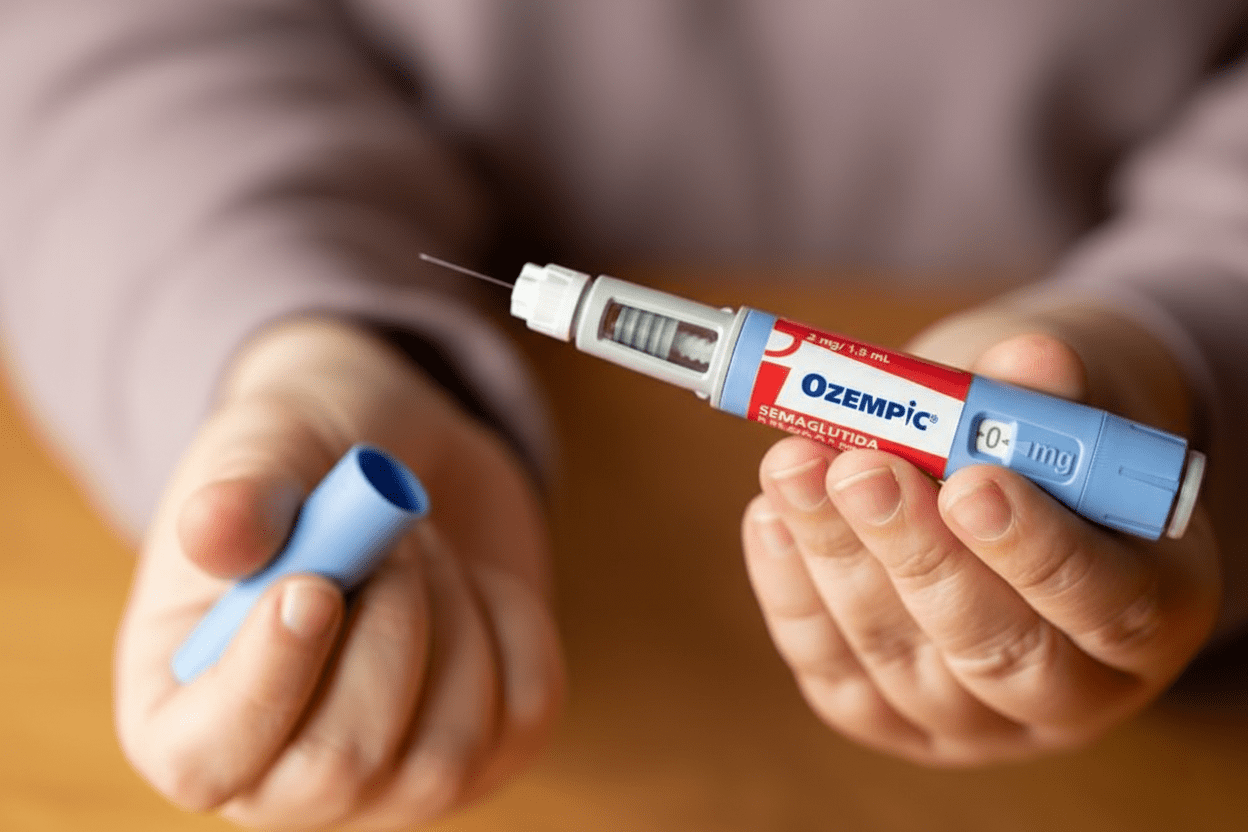Ozempic (Semaglutide) 1 mg Pen: Benefits for Weight Loss and Diabetes Management Explained

If you’ve been researching modern solutions for type 2 diabetes or weight management, chances are you’ve come across Ozempic (semaglutide). While the drug is manufactured in several doses, the 1 mg pen has become one of the most talked-about strengths because it strikes a powerful balance between glycemic control, weight reduction, and tolerability. Below is a deep dive into how the Ozempic 1 mg pen works, who it helps, and why it’s become a go-to option for both doctors and patients.
1. What Is Ozempic (Semaglutide)?
Ozempic is a once-weekly, subcutaneous GLP-1 receptor agonist developed by Novo Nordisk. It mimics the natural hormone glucagon-like peptide-1, which:
- Stimulates insulin secretion when glucose is high
- Suppresses glucagon (a hormone that raises blood sugar)
- Slows gastric emptying, helping you feel full longer
- Acts on appetite centers in the brain to curb hunger
The medication is FDA-approved for type 2 diabetes, but its weight-loss benefits are so pronounced that many clinicians prescribe it off-label for chronic weight management, and its higher-dose sister drug Wegovy is specifically approved for obesity.
2. Understanding the 1 mg Pen
Ozempic comes in a pre-filled, disposable pen that delivers 0.25 mg, 0.5 mg, or 1 mg per injection, depending on how you dial the dose. The 1 mg dose is typically reached after a four-week titration:
| Weeks | Dose |
|---|---|
| Weeks 1–4 | 0.25 mg |
| Weeks 5–8 | 0.5 mg |
| Week 9 onward | 1 mg (maintenance) |
Some patients eventually move to 2 mg weekly if additional A1C reduction is needed, but 1 mg remains the sweet spot for many because it offers robust benefits with manageable side effects.
3. Proven Benefits of the 1 mg Dose
A. Blood-Sugar Lowering (A1C Reduction)
- SUSTAIN 7 trial: Patients on 1 mg Ozempic achieved an average A1C drop of 1.5–1.8% versus placebo.
- ~70% of users reached the ADA target of A1C <7% within 30 weeks.
- Fasting plasma glucose fell by 30–40 mg/dL on average.
B. Weight Loss
Although Ozempic is not officially a weight-loss drug, studies show:
- Average weight loss of 4–6 kg (9–13 lb) at the 1 mg dose over 40 weeks.
- Up to 10% body-weight reduction when combined with lifestyle changes.
- Appetite suppression kicks in within 2–3 weeks, helping users naturally reduce calorie intake.
C. Cardiovascular Protection
- SUSTAIN 6 demonstrated a 26% reduction in major adverse cardiac events (MACE) in high-risk patients.
- The 1 mg dose is now endorsed by the ADA for cardiovascular risk reduction in type 2 diabetes.
D. Convenience & Compliance
- Once-weekly dosing fits busy lifestyles better than daily injections.
- The hidden needle design minimizes injection anxiety.
- Pens can be stored up to 56 days at room temperature after first use—perfect for travel.
4. Real-World Patient Experience
Case snapshot (typical):
Sarah, 48, female, BMI 33, A1C 8.2%, PCOS
- Month 1 (0.25 mg): Mild nausea, 2 lb lost
- Month 2 (0.5 mg): Appetite noticeably lower, 6 lb lost, A1C 7.4%
- Month 4 (1 mg): 12 lb lost, A1C 6.6%, BP down 8 mmHg, no hypoglycemia
“The 1 mg pen feels like the dose where everything clicked—my cravings are gone, portions are half what they used to be, and my morning glucose finally sits under 120 mg/dL.”
5. How to Use the 1 mg Pen Correctly
- Attach a new NovoFine Plus needle every time.
- Dial to your prescribed dose (0.25, 0.5, or 1 mg).
- Inject subcutaneously in abdomen, thigh, or upper arm; rotate sites.
- Use on the same day each week with or without food.
- Store unused pens in the fridge (36–46 °F); after first use, keep at 59–86 °F for max 56 days.
Missed dose?
- If ≤5 days since missed dose, take it ASAP.
- If >5 days, skip and resume normal schedule—never double up.
6. Side-Effect Profile at 1 mg
Most common (incidence ≥5%):
| Side Effect | Typical Onset | Management Tips |
|---|---|---|
| Nausea | Week 1–3 | Eat smaller meals, avoid greasy foods |
| Diarrhea | Week 2–4 | Stay hydrated, consider soluble fiber |
| Constipation | Ongoing | Increase water, add magnesium or prunes |
| Mild headache | Week 1–2 | Adequate fluids, electrolytes |
Serious but rare:
- Acute pancreatitis—discontinue if severe abdominal pain.
- Gallbladder issues—monitor for sudden RUQ pain.
- DKA risk is low but possible; watch for ketones if very ill.
7. Who Should & Shouldn’t Use Ozempic 1 mg
Good candidates:
- Adults with type 2 diabetes needing A1C reduction
- Overweight adults (BMI ≥27) with ≥1 weight-related condition
- Patients seeking cardiovascular risk reduction
Avoid if:
- Personal/family history of medullary thyroid carcinoma
- MEN 2 syndrome
- Pregnancy or planning pregnancy within 2 months
- Severe gastroparesis or history of diabetic retinopathy requiring acute laser (relative contraindication—monitor closely)
8. Cost & Insurance Coverage
- List price: ~$935 per 4-week pen (USA).
- 75–80% of commercial plans now cover Ozempic for diabetes; prior auth often required.
- Manufacturer savings card can drop co-pay to $25 for eligible insured patients.
- Cash-pay options: Canadian or certified international pharmacies ~$320–$350 per pen (ensure VIPPS or CIPA certification).
9. Frequently Asked Questions (FAQ)
Q1: Can I split the 1 mg pen into smaller doses to save money?
A: No—the pen is single-use and not designed for dose splitting; doing so risks infection and inaccurate dosing.
Q2: How long can I stay on 1 mg?
A: Indefinitely, as long as you’re meeting glycemic/weight goals and tolerating it well. Some patients plateau; others stay on 1 mg for years.
Q3: Will I regain weight if I stop?
A: Studies show weight regain of ~60–70% within a year after cessation unless lifestyle changes are maintained. Gradual tapering plus diet/exercise support is key.
Q4: Can I switch from Ozempic 1 mg to Wegovy 1.7 mg or 2.4 mg?
A: Yes, but allow a 2-week washout to avoid stacking side effects, and titrate under medical supervision.
10. Key Takeaways
- The Ozempic 1 mg pen delivers clinically meaningful A1C and weight reductions with a favorable safety profile.
- Once-weekly dosing and built-in titration make it user-friendly.
- Cardiovascular benefits extend beyond glucose control, aligning with modern diabetes care goals.
- Side effects are mostly GI-related and transient; slow meal-time changes mitigate symptoms.
- Cost and access are improving thanks to insurance coverage and manufacturer coupons.



